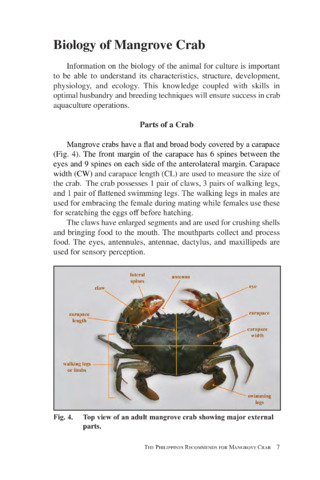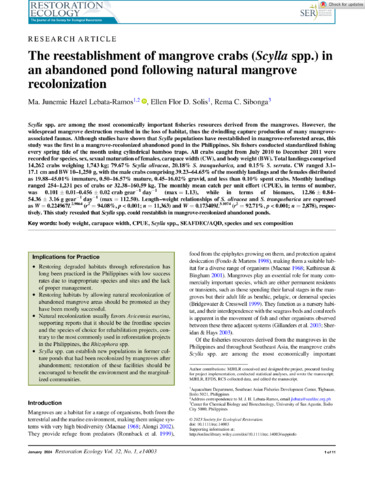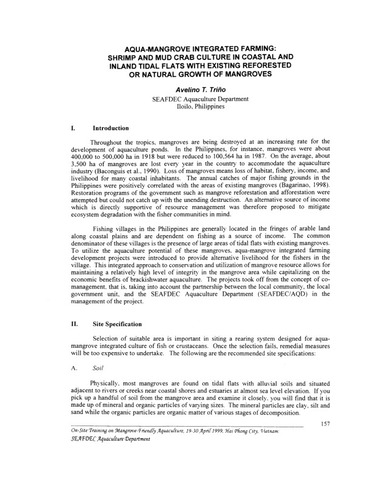Seasonal abundance, distribution and recruitment of mud crabs (Scylla spp.) in replanted mangroves
- Global styles
- MLA
- Vancouver
- Elsevier - Harvard
- APA
- Help

View/
Date
2006Page views
5,933ASFA keyword
AGROVOC keyword
Taxonomic term
Metadata
Show full item record
Share
Abstract
The abundance and distribution of mud crabs were studied in a replanted mangrove forest in Buswang, Aklan, Philippines. Two fishing gears, lift nets and bamboo traps, were used to monitor relative abundance of Scylla spp. populations from March 2002 to December 2003 inside the mangrove forest. A third gear, a stakenet set across a creek, was used to monitor crabs migrating out of the mangroves during the ebb tide. Scylla olivacea formed 99.3% and 70.3% of the catch in the mangrove and the stakenet, respectively. The percentage of Scylla tranquebarica increased from <1% in the mangrove catches to 29% in the stakenet. Scylla serrata was present at very low levels in both catches. The lack of modal progression in the size–frequency plots and the year-round catch rate of gravid females suggested that recruitment was constant throughout the year. Even though relative abundance decreased over the study period indicating that the stock is being over-exploited, mud crab production is more than equivalent to that of most natural mangroves.
Suggested Citation
Walton, M. E., Le Vay, L., Lebata, J. H., Binas, J., & Primavera, J. (2006). Seasonal abundance, distribution and recruitment of mud crabs (Scylla spp.) in replanted mangroves. Estuarine, Coastal and Shelf Science , 66(3-4), 493-500. https://doi.org/10.1016/j.ecss.2005.09.015
Type
ArticleISSN
0272-7714Collections
- Journal Articles [1258]
Related items
Showing items related by title, author, creator and subject.
-
[The Philippines recommends for mangrove crab:] Biology of mangrove crab
The Mangrove Crab Technical Committee 2018 (DOST-PCAARRD, 2021) -
The reestablishment of mangrove crabs (Scylla spp.) in an abandoned pond following natural mangrove recolonization
Scylla spp. are among the most economically important fisheries resources derived from the mangroves. However, the widespread mangrove destruction resulted in the loss of habitat, thus the dwindling capture production ... -
Aqua-mangrove integrated farming: Shrimp and mud crab culture in coastal and inland tidal flats with existing reforested or natural growth of mangroves
Triño, Avelino T. (Aquaculture Department, Southeast Asian Fisheries Development Center, 2000)Throughout the tropics, mangroves are being destroyed at an increasing rate for the development of aquaculture ponds. In the Philippines, for instance, mangroves were about 400,000 to 500,000 ha in 1918 but were reduced ...






